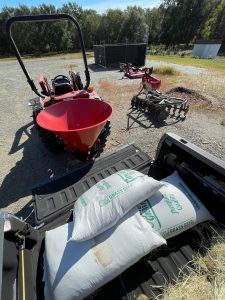Discing and Seeding After the Rain
The rain at last returned on Sunday, the first appreciable moisture in about seven weeks. I have been waiting on another bout of wet stuff before planting ryegrass in Pancho the Donkey’s pasture. Since we had the pond built, that roughly two-acre plot became mainly bare soil, since the dirt guy spread the excavated soil around the pond. Pancho subsists on a bit of grass at the front and back, and the square bales of hay we supply regularly. Plus, there’s the breakfast buffet my Beautiful Mystery Companion provides a few times weekly: a bucket of shredded wheat, apples, grapes, bananas and carrots. Pancho eats well here at No-Name Farm.
By Monday morning, when the sky blazed blue again, I had assembled the necessary implements to seed — all borrowed of course. I had loosened up the dirt before it rained with a disc harrow a buddy loaned me. Pancho dutifully followed me, as always curious. A quick trip to the feed store set me back $166 for three 50-pound sacks of seed and three square bales for Pancho.
Another buddy came by to deliver his seeder and helped me hook it up. The seeder is a conical contraption that hooks to the tractor’s PTO. Turn the PTO on, and the seeder slings the kernels about 20 feet to each side. It works well. I had the entire plot seeded in less than an hour. Next I unhooked the seeder and attached a tractor rake, also borrowed.
I had watched a couple of YouTube videos on using the disc harrow, as well as the seeder. YouTube is invaluable to us hobby farmers, especially to someone with my level of agricultural ignorance. It took at least three how-to videos before I mastered the ungainly maneuver of hooking an implement to the PTO. I am forced into a very uncomfortable position, straddling it while trying not to bang my head on the top piece, holding down the release button and wriggling it on. The click it makes when the collar latches to the PTO is heaven to my ears.
The disc harrow and rake do not use the PTO, just the three-point hitch system hanging from the rear of the tractor. The three arms require a combination of skill and brute force to attach. Getting the tractor lined up so it is square is not easy. In the early days of trying to hook up one implement or another, my little brother Gregg gave me some invaluable advice: Go buy a ballpeen hammer. It comes in handy when forcing the tractor arms onto the disc harrow or a box blade.
The tractor rake proved problematic, either pulling too much soil or not enough. I unhooked it with help from the ballpeen hammer and hooked the disc harrow back up, this time lightly disking the seed into the soil. Pancho was busy licking up the seed from the ground as I worked. About supper time, I was finished.
Now we wait. The soil was plenty wet from the Sunday rain, so the ryegrass should start popping up within a week or so. It will be a couple of months before it is tall enough for Pancho to graze on. In March, it will be time to seed the pastures with Bermuda, hopefully to create permanent pastures. Ryegrass dies out when it gets hot, so by May it will be time to provide him a fresh carpet of grazing material.
In the meantime, we are looking to find Pancho a female companion in hopes of producing a baby donkey. The gestation period for a pregnant ginny is 11 to 14 months.
Nothing happens quickly on No-Name Farm, except the gopher mounds.
Leave a reply
Fields marked with * are required












